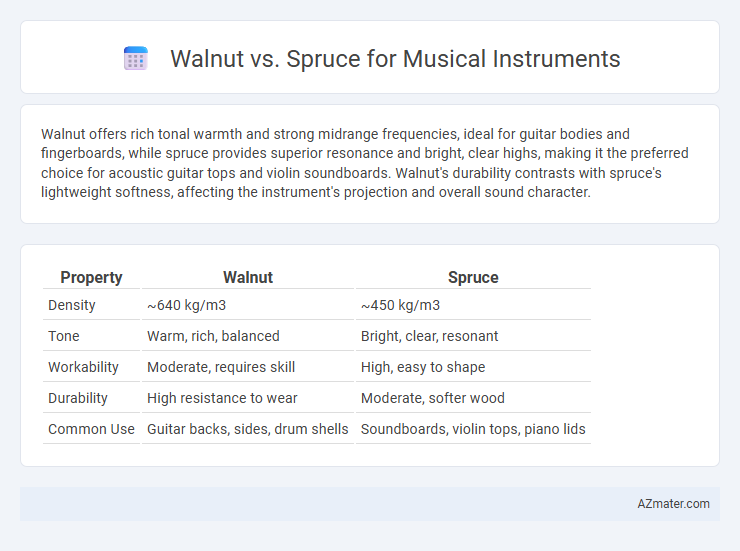Walnut offers rich tonal warmth and strong midrange frequencies, ideal for guitar bodies and fingerboards, while spruce provides superior resonance and bright, clear highs, making it the preferred choice for acoustic guitar tops and violin soundboards. Walnut's durability contrasts with spruce's lightweight softness, affecting the instrument's projection and overall sound character.
Table of Comparison
| Property | Walnut | Spruce |
|---|---|---|
| Density | ~640 kg/m3 | ~450 kg/m3 |
| Tone | Warm, rich, balanced | Bright, clear, resonant |
| Workability | Moderate, requires skill | High, easy to shape |
| Durability | High resistance to wear | Moderate, softer wood |
| Common Use | Guitar backs, sides, drum shells | Soundboards, violin tops, piano lids |
Walnut vs Spruce: An Overview for Musical Instruments
Walnut offers a warm tone with balanced midrange frequencies, making it ideal for guitars and ukuleles seeking rich sound character. Spruce, renowned for its high strength-to-weight ratio, delivers bright, clear, and responsive tones favored in the soundboards of violins, guitars, and pianos. The choice between walnut and spruce depends on the desired tonal warmth and projection, with spruce excelling in resonance and walnut providing enhanced durability and aesthetic appeal.
Tonewood Characteristics: Walnut and Spruce Compared
Walnut offers a warm, balanced tone with strong midrange frequencies and a smooth attack, preferred for its visual appeal and moderately bright sound in guitars and violins. Spruce, especially Sitka spruce, is renowned for its exceptional strength-to-weight ratio, delivering clear, bright, and resonant tones with excellent dynamic range, making it the dominant choice for soundboards in acoustic instruments. The denser grain of walnut provides a slightly darker timbre, while spruce's open grain enables greater projection and responsiveness, influencing the instrument's overall sound character significantly.
Sound Quality Differences: Walnut vs Spruce
Walnut produces a warm, balanced tone with pronounced midrange frequencies, offering a rich and smooth sound ideal for fingerstyle and mellow genres. Spruce delivers a bright, clear, and dynamic tone with strong projection and excellent resonance, favored for its versatility in various musical styles. Choosing between walnut and spruce hinges on the desired sound profile, where walnut emphasizes warmth and clarity, while spruce prioritizes brightness and power.
Durability and Stability: Which Wood Lasts Longer?
Walnut offers excellent durability and moderate stability, making it resistant to wear and suitable for instruments subjected to frequent handling. Spruce, known for its superior strength-to-weight ratio, provides exceptional stability and longevity under tension, particularly favored for soundboards in string instruments. Spruce generally lasts longer due to its ability to maintain structural integrity and resist warping over time compared to walnut.
Aesthetic Appeal: Grain Patterns and Colors
Walnut features rich, dark brown hues with intricate, swirling grain patterns that offer a warm, luxurious aesthetic, often preferred for high-end guitars and string instruments. Spruce provides a lighter, creamy to pale yellow color with a straight, even grain that enhances brightness in appearance and sound, making it a popular choice for soundboards. The contrasting visual qualities of walnut's bold, dramatic grain and spruce's subtle, uniform texture influence the instrument's overall visual character and style.
Weight and Playability: Impact on Musicians
Walnut offers a moderate weight, providing a balance between durability and comfort, which enhances playability for musicians seeking stability without excessive heaviness. Spruce is significantly lighter, contributing to greater ease of handling and faster responsiveness, favored in instruments where agility and sound projection are critical. Musicians often choose walnut for its robust feel and warm tone, while spruce suits those prioritizing lightness and clarity in performance.
Best Applications: Types of Instruments Suited for Each Wood
Walnut, known for its rich brown color and warm tonal qualities, is ideal for crafting guitars, violins, and clarinets where a balanced sound with pronounced midrange frequencies is desired. Spruce, prized for its strength-to-weight ratio and bright, resonant tones, is the preferred choice for soundboards in acoustic guitars, violins, and harps due to its superior vibration and projection characteristics. While walnut offers enhanced aesthetic appeal and a slightly softer sound, spruce provides clarity and dynamic responsiveness critical for stringed instrument tops and wind instrument bodies.
Cost and Availability: Walnut vs Spruce
Walnut wood tends to be more expensive than spruce due to its denser grain and slower growth rate, making it less abundant and harder to source for musical instruments. Spruce is widely available, cost-effective, and favored for soundboards because of its lightweight yet strong characteristics that enhance resonance. The cost difference influences manufacturing decisions, with spruce being the preferred choice for budget-friendly and mass-produced instruments while walnut is reserved for premium, artisanal models.
Popular Choices Among Luthiers and Musicians
Walnut is favored by luthiers for its balanced tonal qualities, blending warmth with clarity, making it a popular choice for acoustic guitar bodies and backs. Spruce is highly regarded for its superior resonance and dynamic range, commonly used in the tops of acoustic instruments to deliver bright, articulate sound favored by many musicians. Both woods are praised in the instrument-making community, with walnut chosen for unique aesthetic appeal and mellow tone, while spruce remains the standard for projection and responsiveness in soundboards.
Conclusion: Choosing the Right Wood for Your Instrument
Spruce offers superior resonance and brightness, ideal for soundboards in guitars and violins, enhancing tonal clarity and projection. Walnut, with its dense grain and warm tonal qualities, provides a balanced sound with rich midrange frequencies, suited for back and sides or entire instrument bodies. Selecting the right wood depends on desired sound profile: spruce favors sharp, vibrant tones, while walnut delivers warmth and depth, making both essential choices tailored to specific musical styles and instrument types.

Infographic: Walnut vs Spruce for Musical instrument
 azmater.com
azmater.com